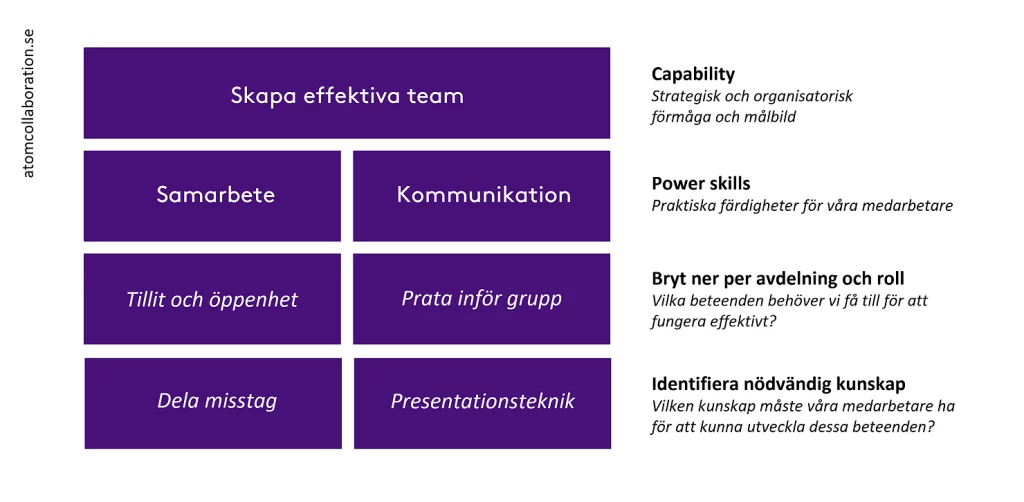Skills have come to be called “the new currency” as people look for ways to build on future skills to stay relevant in the labor market. Here, we as a company have a crucial role in creating conditions for development and offering effective solutions to grow and build on knowledge.
Many companies have invested in employee culture, digitalization and innovation in recent years, but it may be time to seriously invest in a skills strategy. The world is changing faster than ever. According to a report by the World Economic Forum, we are in the midst of a transformation where 85 million jobs will disappear and 97 million new jobs will be created by 2025, creating many new roles and skills. One way for companies to keep up and identify skills needs now and in the future is to create a strategy based on a skills taxonomy.
But what do your skills really mean? There are many different concepts that circulate and are widely discussed by different theorists in the field, and they are also interpreted differently depending on the context and language. But in order to start working strategically with skills, it is important to clarify what the different concepts mean in relation to learning and development.

Knowledge is theoretical knowledge that you can read or learn. “Capabilities”, as an increasingly common concept, are strategic and organizational abilities and behaviours that we use more broadly all the time, in a variety of situations and contexts. A skill is the ability to do something practical in a specific situation. Skills are abilities that you become good at performing through practice and training. Hard skills are technical and specific skills, such as “programming”. Soft skills are more complex behaviors such as “effective teamwork”. Many soft skills are now called power skills, which are the skills that are essential for today’s changing workplace. Building a power skill often takes many years of practice, training and experience. Upskilling is when you update and improve the skills you already have (you become more specialized). Reskilling is when you learn and acquire completely new skills (to work in a new role). Competence is a collective term for the ability, knowledge and effectiveness of an organization or individual to perform a task by applying knowledge and skills.

What is a skills taxonomy and how do you make one?
A skills taxonomy is a kind of classified list of identified skills an organization needs now and in the future. The advantage of working comprehensively with skills throughout the organization is that they become common umbrella skills that all employees can develop. It can improve collaboration across departments and between roles but also increase internal mobility – changing jobs within the organization becomes easier. It also makes the upskilling and reskilling work more sustainable and can be built on over time. Skills are divided into groupings that summarize hard and soft skills based on the organization’s overall desired common abilities and behaviors. Titles of skill groups can be, for example, “software development” or “collaboration”. Only after you have identified the overall skill groupings do you break them down into specific skills that different departments or roles need to develop.
But how can companies identify their skills needs? McKinsey suggests that you start by listing 25 skills that all employees need, and 10 specialist skills. The first thing you can do is identify existing skills gaps (areas that the organization needs to improve now or in the near future) that can be monitored and measured. Then you can formulate skills based on the competence needs that support the company’s business strategy. The last thing you can do is add skills that align with the moves your organization needs to make as the world changes. Here you can find inspiration by looking, for example, at the future skills the World Economic Forum predicts companies will need, but there are also specific industry reports showing future trends.

Once you as an organization have identified the skill groups you need to focus on, you can set up a plan for the specific skills different departments and roles need and how you can use different forms of learning initiatives to close the skills gap. Josh Bersin of Deloitte, among others, states that that working with upskilling and reskilling based on a skills taxonomy is not an individual work for HR, but should be a work that flows across all departments where different competence movements should be led by department managers or area specialists, and that it is most important as an organization to invest in upskilling and reskilling in future power skills.
When it comes to measuring, testing and certifying skills (which are often a threshold for advancement), think of it this way: Hard skills such as programming can be purchased in ready-made courses, both digital and physical, that offer certification and ready-made tests. However, when it comes to power skills, you can skip classic certification and instead allow employees to carry out a self-assessment based on a few simple questions on a scale of 1-5, ranging from “don’t know anything” to “I’m an expert”. After all, these are skills that you must practice by practicing, training and building on continuously to become truly “skilled” in them.
But which skill groups and power skills should companies invest in to be prepared for the challenges of the future? You can read more about this in next week’s article: “Talking about skills: Which power skills should we as a company invest in to be ready for the future?”.
Sources and read more:
Why skills strategy https://www.linkedin.com/business/talent/blog/learning-and-development/what-is-a-skills-taxonomy-and-why-do-you-need-it
Good guide on upskilling and reskilling https://www.ihm.se/i-fokus/kunskap/upskilling-din-kompletta-guide/
McKinsey & Company skills-gap method Using skill gap assessments to help future-proof your organization | McKinsey & Company
Capability vs Skill https://medium.com/the-future-of-workplace-learning/how-to-describe-the-difference-between-a-capability-and-a-skill-13f1ac42434f
Josh Bersin, Deloitte on Skills Taxonomy https://joshbersin.com/podcast/what-is-a-skills-taxonomy-anyway-understanding-the-market-for-skillstech/




